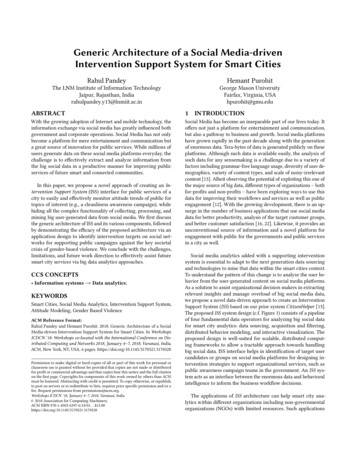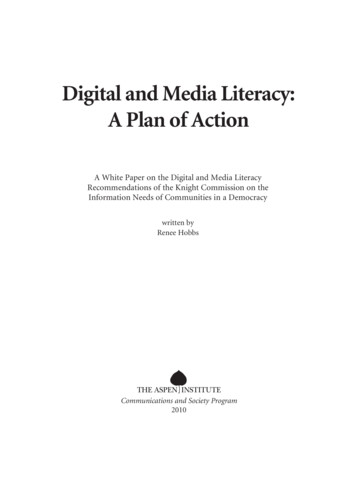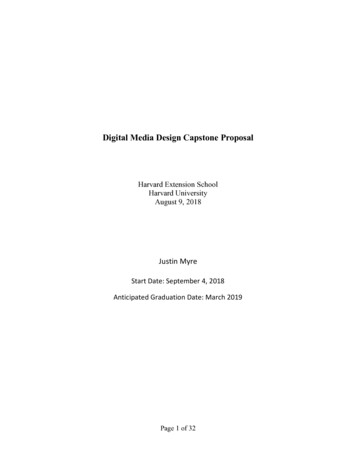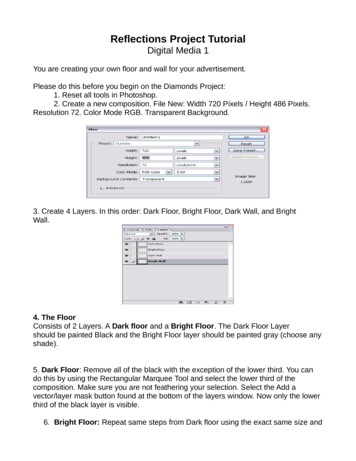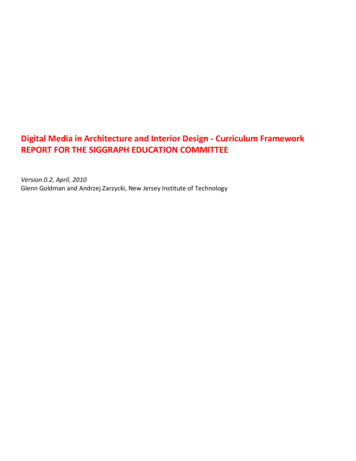
Transcription
Digital Media in Architecture and Interior Design - Curriculum FrameworkREPORT FOR THE SIGGRAPH EDUCATION COMMITTEEVersion 0.2, April, 2010Glenn Goldman and Andrzej Zarzycki, New Jersey Institute of Technology
Digital Media in Architecture and Interior Design - Curriculum FrameworkVersion 0.2, April 2010Glenn Goldman and Andrzej Zarzycki, New Jersey Institute of TechnologyINTRODUCTION/BACKGROUNDBoth Architecture and Interior Design are licensed and/or certified professions in the United States requiring degreesaccredited by profession-specific bodies, national examinations, and supervised internships - all of which are regulated byindividual states charged with protection of the health, welfare, and safety of their citizens and general public.The licensing of architects is close to uniform throughout the fifty states, requiring degrees from programs accredited bythe National Architectural Accrediting Board (NAAB) and national examination administered by the National Council ofArchitectural Registration Boards (NCARB). National certification of individuals and state-by-state reciprocity is generallyadministered by NCARB. NAAB was founded in 1940 to “produce and maintain current a list of accredited schools ofarchitecture in the United States and its possessions ” and since 1975 modified its role to the accreditation ofprofessional degree programs rather than schools or universities. The licensing and registration of interior designers is acomparatively newer phenomenon and varies from state to state, some of which accepted licensed architects as interiordesigners when certification became prevalent in the 1990s. In general, the right to use the title of Certified InteriorDesigner requires a degree in Interior Design accredited by the Council for Interior Design Accreditation (CIDA) andpassage of the NCIDQ (National Council for Interior Design Qualification) examination. CIDA requirements include nonprofessional courses defined as liberal arts and sciences but “programs located in an institution accredited by a regionalaccrediting body recognized by the U.S. Department of Education do not need to provide additional proof that they meetCIDA’s liberal arts and sciences requirement.” [p. II-4, CIDA Accreditation Manual].Each profession has associated organizations in the United States: the American Institute of Architects (AIA) for architects,and the American Society of Interior Designers (ASID) and the International Interior Design Association (IIDA) for interiordesigners. The appellations “AIA” or “FAIA”, “ASID” or “FASID”, and “IIDA” or “FIIDA” may be used by professionalmembers of their respective associations. While professional membership in the AIA and ASID are restricted to theirrespective disciplines, the IIDA accepts professional members who are either NCIDQ (interior design) or NCARB(architecture) certified.Although the National Association of Schools of Art and Design (NASAD) includes interior design as a discipline within itspurview, neither NAAB nor CIDA require accreditation by NASAD. However, schools must be accredited by an accreditingbody recognized by the U.S. Department of Education and Council for Higher Education Accreditation (e.g. Middle StatesAssociation of Colleges and Schools/Middles States Commission on Higher Education, New England Association of Schoolsand Colleges Commission on Institutions of Higher Education, Northwest Commission on Colleges and Universities,Southern Association of Colleges and Schools Commission on Colleges, etc.).Performance criteria and standards evaluated by both inputs and outputs are focused on those items deemed critical fordesigners of our built environment. In addition to design, specific expertise is required in a variety of technical subjectsthat include mechanical and environmental systems for both architects and interior designers, detailed (architects) orgeneral (interior designers) knowledge of, and the ability to incorporate, structural systems into a design, and so on.Consequently, the use of information technology and computer graphics have subsidiary roles in service of design, designdevelopment, and production of contract documents. In particular, graphics are used to communicate - to ourselves asdesigners, to clients, to peers and in an academic context critics, to regulatory agencies having jurisdiction and approvalrights for projects, to consultants (e.g. mechanical and structural engineers), and to the contractors who will bid on, andultimately create, the physical manifestation of the design.
ACCREDITATION REQUIREMENTS REFERENCING OR INCORPORATING (COMPUTER) GRAPHICSInterior Design/CIDA:Standard 6. CommunicationEntry-level interior designers are effective communicators.Student Learning Expectations:a) Students apply a variety of communication techniques and technologies appropriate to a range of purposes andaudiences.Students are able to:b) express ideas clearly in oral and written communication.c) use sketches as a design and communication tool (ideation drawings).d) produce competent presentation drawings across a range of appropriate media.e) produce competent contract documents including coordinated drawings, schedules, and specifications appropriate toproject size and scope and sufficiently extensive to show how design solutions and interior construction are related.f) integrate oral and visual material to present ideas clearly.[Apply/Ability/Able – competent entry-level skills that must be demonstrated in completed student work]Standard 15. Program Administrationm) Equipment is available and appropriate to support program objectives and course goals.** Examples of equipment include computers, printers, plotters, projectors, monitors/VCRs/DVDs.Architecture/NAAB:Student Performance Criteria 13.3 - Graphic SkillsAbility to use appropriate representational media, including freehand drawing and computer technology, to conveyessential formal elements at each stage of the programming and design process.Student Performance Criteria 13.26 - Technical DocumentationAbility to make technically precise drawings and write outline specifications for a proposed design.Student Performance Criteria 13.28 - Comprehensive DesignAbility to produce a comprehensive architectural project based on a building program and site that includes developmentof programmed spaces demonstrating an understanding of structural and environmental systems, building envelopesystems, life-safety provisions, wall sections and building assemblies and the principles of sustainability.In order to be able to fully utilize information technology in service of architecture and interior design, it is necessary forstudents to learn, at the very least, basic principles of computer graphics and be able to creatively utilize a variety ofapplications. In order to accomplish their tasks architects and interior designers both need an array of tools that includeraster graphics/paint programs, three-dimensional modeling and visualization software (including the ability to animate orcreate walk-throughs), technical drawing applications, image processing software, illustration and compositingapplications, building information modeling software, and a bevy of analytical tools to study design implications oflighting, structure, energy use, acoustics, etc.
CURRICULAR IMPLICATIONSProfessional programs in the twenty-first century should include the use of information technology in both design studiosand support courses. However it may be inappropriate to dictate exactly how those tools are integrated. Althoughprescriptive criteria (i.e. the elucidation of particular courses and syllabi that must be taught) are easy to judge from adistance by accrediting bodies, this can stifle innovation and may not always be the most appropriate match for particularinstitutions, available faculty, or a particular student group. Comprehensive projects by both architects and interiordesigners (including detailed design proposals, outline specifications, schematic structural design for architects, materialand furniture selection for interior designers, etc.) should illustrate proficiency in the use of information technology. Whilevisualization can certainly occur with traditional media, the quality and quantity demanded by professionals can be mosteffectively accomplished with digital media. Criteria for accreditation and curriculum development should be sufficientlyrigorous to establish a de facto standard of use of information technology. Certain “products” (in some professionalcontexts referred to as “deliverables”) like contract documents with building information models or “walk-throughs”illustrating proposed designs can only be created using computer graphics. In the 2009-2010 academic year, CIDAmodified its standards to eliminate the explicit requirement of “competence in drafting and lettering, both manual andcomputer-aided techniques” and other medium-specific requirements in favor of the more general performance criterialisted above; but still requires a demonstrated proficiency in the creation of presentation/visualization work across a“range of appropriate media” without providing additional guidance or interpretation which may, or may not, lead todiscussion (or confusion) during the accreditation process about the definitions and limitations of appropriate media. Itshould be noted that while “sketches” are required, and in contrast to the requirements for architecture, the standardsfor interior design do not require any demonstrated use of information technology by students for accreditation as“across a range of appropriate media” may be interpreted to include the variety of traditional media used for decades. Itis assumed, however, that given the demands of the profession, computer graphic skills have to be part of any interiordesign curriculum just as they are for architecture. Moreover, as both interior designers and architects have increasedconcern about, and responsibility for, sustainability (as well as LEED certification for projects), computational tools thatinclude graphic representations of data that have few equivalents in traditional media become more important.It is possible that some programs may choose to deliver skill acquisition via discrete courses. Some may choose tointegrate virtually all of the computer graphic skills within the design studio. And a number of programs are likely to havea combination of introductory and advanced courses along with reinforcement and instruction in the design studiocontext. What is most effective in all cases, and consistent with the findings and discussion held at the Computer GraphicsEducators Workshop in Eurographics 2009 (Munich, Germany), is that the instruction in computer graphics will be done inthe context of the design disciplines. There are successful cases even in the same university where the graphiccommunication course is coordinated lock-step with the design studio and also when communication courses arecompletely independent. What is consistent, however, is that students are given assignments that are relevant to theirparticular discipline and then required to complete a specific and often discipline-related task, thereby creating a need-toknow for a particular application or skill. In architecture, there is an emerging trend to combine technical and“sustainable” design courses with computational performance simulation and analysis. These courses include computergraphics as an important visual communication tool for simulated data in a manner that becomes useful to architects andstudents as they seek to integrate this feedback into design proposals. Advanced, optional material may also be studied inseparate courses or within advanced “option studios” commonly offered to upper level students.An incomplete web survey and anecdotal evidence indicate that there are a few discrete required courses in computergraphics available within many architecture and/or interior design programs. Where programs have courses in disciplinespecific graphics, the work tends to be digitally created. While most schools continue to teach and require the use offreehand drawing with traditional media, most (although not all) have eliminated traditional t-square and parallel ruledrafting. These general and architectural graphic and visual communication courses have supplanted the “computergraphics” courses previously required. Nevertheless, there are a number of schools whose commitment to pushing theboundaries of digital media and the use of information technology in architecture and interior design are evident in abroad array of elective and required courses dealing with computer graphics (examples of online catalog descriptionsfollow). Many schools have a “special topics” course or equivalent that allows for a variety of classes to be offered, manyof which deal with different issues related to and involving computer graphics and other information technology uses, andare offered on an ad hoc basis depending on student and faculty interest as well as available resources.
Despite the fact that many schools offer few electives or discrete courses in computer graphics, it is clear that the materialis taught. In order to provide students with the knowledge to enter their chosen professions, schools are obligated to seethat there is some level of proficiency in the use of computer graphics and information technology. (Although it must bestated that it is equally clear that the level(s) of graphic proficiency vary from student to student, school to school, andbetween programs due to many variables - from available resources to faculty interest to the local demands of industry,and so on.) Furthermore, given the packed nature and requirements of accredited programs, it is evident that graphiccommunication and the use of digital media are reinforced (and sometimes introduced) in the design studio and technicalsupport courses. Therefore it must be assumed that virtually all prog
Both Architecture and Interior Design are licensed and/or certified professions in the United States requiring degrees accredited by profession-specific bodies, national examinations, and supervised internships -all of which are regulated by individual states charged with protection of the health, welfare, and safety of their citizens and general public.

